170: Difference between revisions
Pbcjohnston (talk | contribs) Finished adding photos |
Pbcjohnston (talk | contribs) mNo edit summary |
||
| (9 intermediate revisions by 2 users not shown) | |||
| Line 1: | Line 1: | ||
[[File:Header | {{#seo:|title=submarine USS Cachalot (SS-170) - PigBoats.COM|title_mode=replace}} | ||
{{#seo:|description=Photographs and pictures of the submarine USS Cachalot (SS-170)}} | |||
[[File:New Header Cuttlefish.jpg]] | |||
[[File:Cachalot on ways-1.jpg|left|500px]] | [[File:Cachalot on ways-1.jpg|left|500px]] | ||
| Line 9: | Line 12: | ||
[[File:Cachalot on ways-2.jpg|left|500px]] | [[File:Cachalot on ways-2.jpg|left|500px]] | ||
<div style="text-align: justify;"><span style="color:#00008B">Just over one year later, on October 18, 1933, the progress in building Cachalot has been tremendous. She is nearly ready for launching. Her two stern torpedo tube outer doors can be seen in this photo. Unlike the later fleet boats, these earlier boats didn't have shutter doors to fair into the hull and reduce drag. The size of Cachalot can seen by the two men standing on the | <div style="text-align: justify;"><span style="color:#00008B">Just over one year later, on October 18, 1933, the progress in building Cachalot has been tremendous. She is nearly ready for launching. Her two stern torpedo tube outer doors can be seen in this photo. Unlike the later fleet boats, these earlier boats didn't have shutter doors to fair into the hull and reduce drag. The size of Cachalot can seen by the two men standing on the photograph's right edge. | ||
Some crew are standing on deck perhaps in making preparation for launching the next day. Just on the forward edge of the rudder two plates can be seen bolted to the rudder itself. These are made of Zinc and are sacrificial in nature being the least 'noble' of the metals and will corrode away before the harder and more important metals of the hull. There is also one near where the propeller shaft exits the shaft tube. | Some crew are standing on deck perhaps in making preparation for launching the next day. Just on the forward edge of the rudder two plates can be seen bolted to the rudder itself. These are made of Zinc and are sacrificial in nature being the least 'noble' of the metals and will corrode away before the harder and more important metals of the hull. There is also one near where the propeller shaft exits the shaft tube. | ||
| Line 35: | Line 38: | ||
[[File:Red bar sub new.jpg]] | [[File:Red bar sub new.jpg]] | ||
[[File: | [[File:C-1-a colorized.jpg|left|500px]] | ||
<div style="text-align: justify;"><span style="color:#00008B">A fine port bow shot of Cachalot, probably in a Caribbean port, approximately 1934, not long after her commissioning.</span> | <div style="text-align: justify;"><span style="color:#00008B">A fine port bow shot of Cachalot, probably in a Caribbean port, approximately 1934, not long after her commissioning.</span> | ||
| Line 42: | Line 45: | ||
[[File:Red bar sub new.jpg]] | [[File:Red bar sub new.jpg]] | ||
[[File: | [[File:c-1-b colorized.jpg|left|500px]] | ||
<div style="text-align: justify;"><span style="color:#00008B">Cachalot alongside in a Caribbean port approximately 1934. Although this boat | <div style="text-align: justify;"><span style="color:#00008B">Cachalot alongside in a Caribbean port, approximately 1934. Although this boat was eventually refitted with one of the earliest air-conditioning plants, the harsh Caribbean sun could greatly warm the interior so a temporary awning has been erected amidships.</span> | ||
<small>Original photo in the private collection of Ric Hedman</small> | <small>Original photo in the private collection of Ric Hedman</small> | ||
| Line 49: | Line 52: | ||
[[File:Red bar sub new.jpg]] | [[File:Red bar sub new.jpg]] | ||
[[File: | [[File:c-1-c colorized.jpg|left|500px]] | ||
<div style="text-align: justify;"><span style="color:#00008B">A view of Cachalot from the port quarter in a Caribbean port approximately 1934. The raised covers on the deck aft of amidships cover the main engine mufflers.</span> | <div style="text-align: justify;"><span style="color:#00008B">A view of Cachalot from the port quarter in a Caribbean port, approximately 1934. The raised covers on the deck aft of amidships cover the main engine mufflers.</span> | ||
<small>Original photo in the private collection of Ric Hedman</small> | <small>Original photo in the private collection of Ric Hedman</small> | ||
| Line 56: | Line 59: | ||
[[File:Red bar sub new.jpg]] | [[File:Red bar sub new.jpg]] | ||
[[File: | [[File:c-1-d colorized.jpg|left|500px]] | ||
<div style="text-align: justify;"><span style="color:#00008B">A close up of the conning tower fairwater from aft, taken at the same time as the photos above. Bedding is being aired. The topside watch is looking around the back of the conning tower fairwater.</span> | <div style="text-align: justify;"><span style="color:#00008B">A close up of the conning tower fairwater from aft, taken at the same time as the photos above. Bedding is being aired. The topside watch is looking around the back of the conning tower fairwater.</span> | ||
| Line 63: | Line 66: | ||
[[File:Red bar sub new.jpg]] | [[File:Red bar sub new.jpg]] | ||
[[File: | [[File:Cachalot Cuttlefish Shark.JPG|left|500px]] | ||
<div style="text-align: justify;"><span style="color:#00008B">Cachalot | <div style="text-align: justify;"><span style="color:#00008B">C1 Cachalot (SS-170), C2 [[171|'''Cuttlefish (SS-171)''']], and P3 [[174|'''Shark (SS-174)''']] moored in a nest in San Diego, 1937. This is a screenshot from the Warner Bros. film ''Submarine D-1''. This scene had the Pacific Fleet submarine force gathering in San Diego for a major exercise. Prominent on the front of the conning tower fairwaters are the boat's bell and horns for the air whistle. | ||
<small>Photo courtesy of Cosmopolitan Productions and Warner Bros.</small> | |||
[[File:Red bar sub new.jpg]] | |||
[[File:Cachalot circa 1937.jpg|left|500px]] | |||
Cachalot shown underway in the Thames River, CT., summer of 1937. She is headed up river to Submarine Base New London after having completed a three year deployment to the west coast operating out of San Diego. She still has her class identifier, C1, on her bow, indicating this is in the period after submarines were painted black (starting in 1935) and before they had the class identifiers removed in favor of their hull numbers in 1939. | |||
The tripod masts on the forward and aft decks supported the long-range radio aerial antenna wires and the mine clearance wires. | |||
Her 3"/50 caliber Mk 11 gun is mounted on the after deck. This mount was the high pedestal type that allowed the gun to elevate up to 88°, giving it a theoretical anti-aircraft capability. However, in actual use this capability was rarely exercised for several reasons. First, operational doctrine argued against it, second the gun was slow to train and elevate being completely man powered, and third rarely if ever was the properly fused ammunition issued to the boats. | |||
<small> | <small>Original photo in the private collection of Ric Hedman.</small> | ||
[[File:Red bar sub new.jpg]] | [[File:Red bar sub new.jpg]] | ||
Latest revision as of 15:21, 8 May 2025
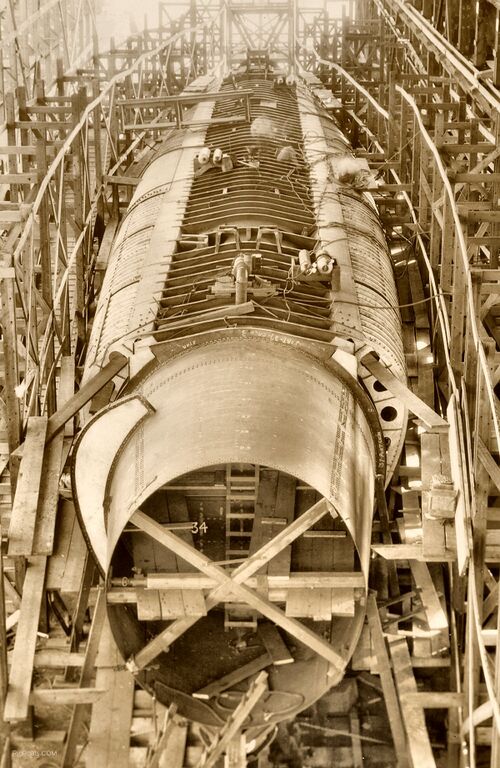
Photo from the Rick Larson Collection
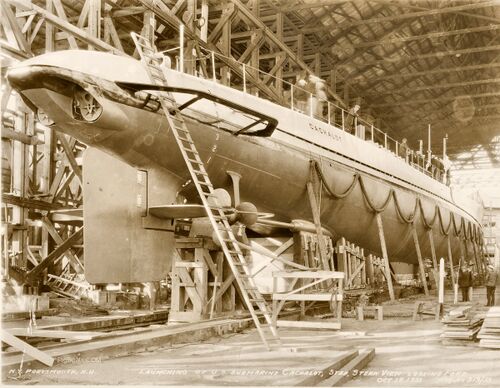
Some crew are standing on deck perhaps in making preparation for launching the next day. Just on the forward edge of the rudder two plates can be seen bolted to the rudder itself. These are made of Zinc and are sacrificial in nature being the least 'noble' of the metals and will corrode away before the harder and more important metals of the hull. There is also one near where the propeller shaft exits the shaft tube.
Photo from the Rick Larson Collection
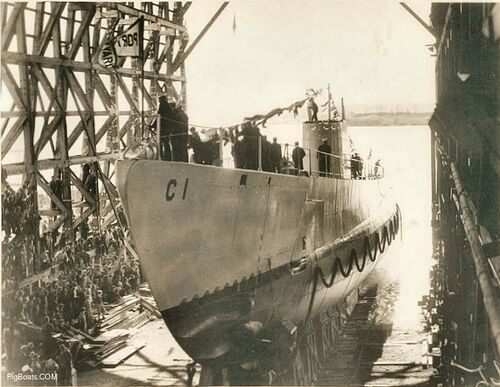
The chains draped on the side of the hull were used to slow the boat as it slid down the ways on the launch cradle. They prevented the boat from sliding too far out into the Piscataqua River. The Portsmouth Navy Yard pennant is flying from the jackstaff.
Photo courtesy of Senior Chief Don

In the background, to the left of the conning tower, Star Island can be seen with the Oceanic Hotel. At the far left at the top edge of the photo Lunging Island can just be made out. This places the Cachalot on an easterly heading just off the north shore of White Island. To the right the horizon has been painted out by the newspaper artists. There a number of small "tweaks" made by the newspaper artists to enable the photo to print with better definition.
News photo in the private collection of Ric Hedman
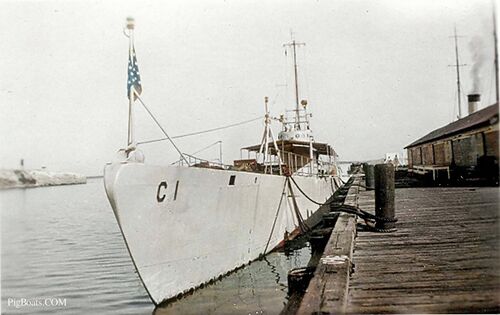
Original photo in the private collection of Ric Hedman
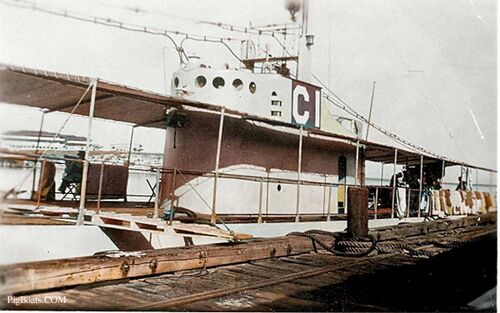
Original photo in the private collection of Ric Hedman
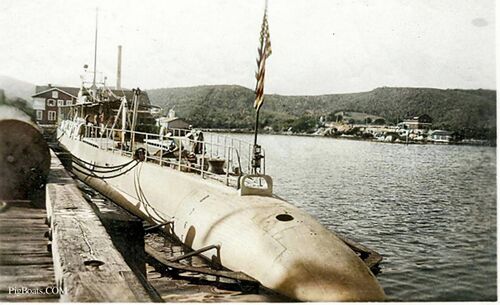
Original photo in the private collection of Ric Hedman
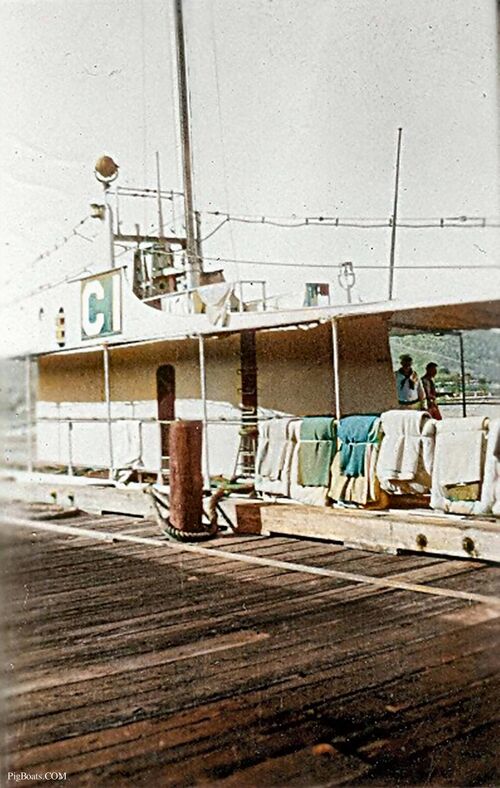
Original photo in the private collection of Ric Hedman
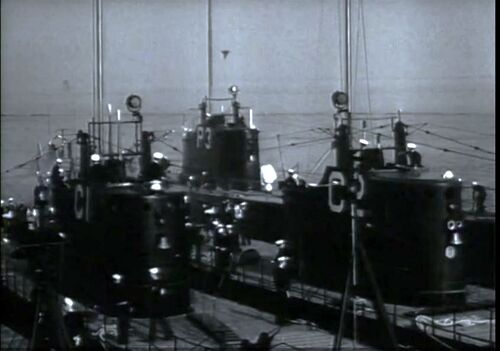
Photo courtesy of Cosmopolitan Productions and Warner Bros.

Cachalot shown underway in the Thames River, CT., summer of 1937. She is headed up river to Submarine Base New London after having completed a three year deployment to the west coast operating out of San Diego. She still has her class identifier, C1, on her bow, indicating this is in the period after submarines were painted black (starting in 1935) and before they had the class identifiers removed in favor of their hull numbers in 1939.
The tripod masts on the forward and aft decks supported the long-range radio aerial antenna wires and the mine clearance wires.
Her 3"/50 caliber Mk 11 gun is mounted on the after deck. This mount was the high pedestal type that allowed the gun to elevate up to 88°, giving it a theoretical anti-aircraft capability. However, in actual use this capability was rarely exercised for several reasons. First, operational doctrine argued against it, second the gun was slow to train and elevate being completely man powered, and third rarely if ever was the properly fused ammunition issued to the boats.
Original photo in the private collection of Ric Hedman.
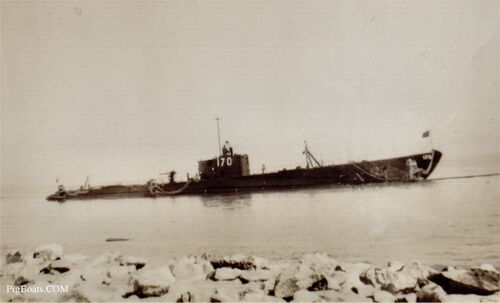
The 3"/50 cal Mk 17 deck gun is very prominent in this photo. The mount that the gun is on allowed it to be elevated to as high as 85 degrees to give it a nominal anti-aircraft capability. However, in practice it made a poor anti-aircraft gun. Not only did the doctrine of the day not support it, but this manually trained and sighted gun was difficult to move and point quickly enough for anti-aircraft use. Also, the boats were rarely supplied with the proper ammo so training really lacked. The ammo they did get lacked the necessary punch to finish off surface targets quickly enough. In short, the gun looked impressive but was essentially useless.
The mod to the cigarette deck was probably done in 1937 during her extensive overhaul at the New York Navy Yard. She returned to the Pacific in June 1939 the same year this photo was developed at The Owl Drug Company, probably at their San Diego or San Francisco store, on November 2, 1939. Other than three early war patrols Cachalot spent the majority of the war as a training submarine at the New London Submarine Base. Her deck gun, though moved from aft of the con to the forward position, was never replaced with a heavier gun.
Original photo in the private collection of Ric Hedman
Page created by:
Ric Hedman & David Johnston
1999 - 2023 - PigBoats.COM©
Mountlake Terrace, WA, Norfolk, VA
webmaster at pigboats dot com
